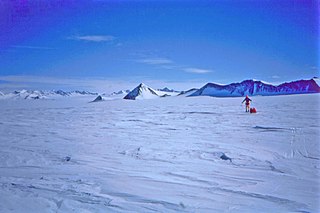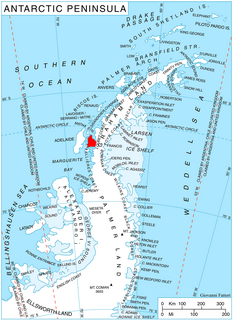Mount Wilcox is a mountain with a sharp, rocky, triangular peak surmounting the southeast corner of Square Bay, 13 kilometres (8 mi) east of Camp Point on the west coast of Graham Land, Antarctica. The mountain was apparently first seen and roughly charted in 1909 by the French Antarctic Expedition under Charcot. It was surveyed in 1936 by the British Graham Land Expedition (BGLE) under John Rymill and was photographed from the air in 1940 by the United States Antarctic Service (USAS). The name, proposed by Colonel Lawrence Martin, is for Phineas Wilcox, mate on the Hero, in which Captain Nathaniel Palmer explored the Antarctic mainland south of Deception Island in 1820.
The Bennett Islands are a group of islands at the southwest side of Liard Island in Hanusse Bay, extending in a southwest direction for 10 km (6 mi) off the west coast of Graham Land. The islands were sighted and sketched from the air in February 1937 by the British Graham Land Expedition under John Rymill. They were named in 1954 by the UK Antarctic Place-Names Committee for Arthur G. Bennett, British representative on whaling in the South Shetland Islands and South Orkney Islands for many years between 1913 and 1927, and acting government naturalist in the Falkland Islands, 1924–38.

Athene Glacier is a glacier, 10 miles (16 km) long, flowing east and merging with the terminus of Casey Glacier where it discharges into Casey Inlet, on the east coast of the Antarctic Peninsula.
Bauer Buttress is a projecting rock buttress on the northeast side of Mount Rendu on Arrowsmith Peninsula, Loubet Coast, Graham Land. It was named by the UK Antarctic Place-Names Committee following geological work by the British Antarctic Survey, 1980–81, after Albert Bauer, French engineer and glaciologist who conducted research on glaciers in Iles Kerguelen, Adelie Coast, Greenland, and Iceland and was formerly with Expéditions Polaires Françaises.
Mount Boyles is, at 1,485 metres (4,870 ft), the highest peak in the Thomas Mountains, located south of the Sweeney Mountains in Palmer Land. It was discovered and roughly mapped by the Ronne Antarctic Research Expedition, 1947–48, led by Commander Finn Ronne, U.S. Navy Reserve. It was mapped in greater detail by the United States Geological Survey (USGS) from surveys and from U.S. Navy aerial photographs, 1961–67, and named by the Advisory Committee on Antarctic Names following the visit of a USGS geological party, 1977–78, after Joseph M. Boyles, a geologist with the party.

Centurion Glacier is a small steep glacier flowing northwest to Neny Bay between Mount Nemesis and Roman Four Promontory, on the west coast of Graham Land.
Cetus Hill is a large ice-covered mound which comes to a point with three jagged rock peaks at its west end. It is located at the head of Ryder Glacier in western Palmer Land, about 27 nautical miles (50 km) east-northeast of Gurney Point. It was named by the UK Antarctic Place-Names Committee after the constellation of Cetus.
Clements Island is an island 1 nautical mile (2 km) long lying immediately south of Rabot Island in the Biscoe Islands. The French Antarctic Expedition, 1903–05, under Jean-Baptiste Charcot, gave the name Ile Clements Markham for Sir Clements Markham, President of the Royal Geographical Society, 1893–1905. Charcot applied this name to an incompletely defined island northeast of Renaud Island, in what is now the Pitt Islands. The recommended application, however, is based upon the map of the British Graham Land Expedition, 1934–37, which provided a more reliable chart of the area. The first part of the name, rather than the last, has been retained to distinguish this feature from Markham Island in Terra Nova Bay, Victoria Land.

Swithinbank Glacier is a glacier on the west side of Hemimont Plateau flowing north to the southeast corner of Square Bay, in Graham Land. Mapped by Falkland Islands Dependencies Survey (FIDS) from surveys and air photos, 1946-59. Named by United Kingdom Antarctic Place-Names Committee (UK-APC) for Charles Swithinbank, British glaciologist, a participant in several British, New Zealand and American expeditions to Antarctica, 1949-62.
Strong Peak is a small sharp peak at the end of a ridge in the Enterprise Hills, standing 3 nautical miles (6 km) west-southwest of Parrish Peak and overlooking the head of Horseshoe Valley, Heritage Range. It was mapped by the United States Geological Survey (USGS) from surveys and U.S. Navy air photos from 1961-66. It was named by the Advisory Committee on Antarctic Names (US-ACAN) for Jack E. Strong, a United States Antarctic Research Program (USARP) biologist at Palmer Station in 1965.
Morris Peak is a prominent peak, 910 metres (3,000 ft) high, marking the northwest end of the Duncan Mountains of Antarctica, at the east side of the mouth of Liv Glacier where the latter enters Ross Ice Shelf. It was named by the Advisory Committee on Antarctic Names for Lieutenant Commander H.C. Morris, U.S. Navy, commanding officer of the USS Mills during Operation Deep Freeze 1963.
Mimas Peak is a sharp conspicuous peak, rising to about 1,000 metres (3,300 ft) west of the head of Saturn Glacier and 9 nautical miles (17 km) west of the Dione Nunataks in the southeast part of Alexander Island, Antarctica. It was first seen and photographed from the air by Lincoln Ellsworth on November 23, 1935, and mapped from these photos by W.L.G. Joerg. The peak was sighted from a distance in 1949 by the Falkland Islands Dependencies Survey (FIDS) and roughly positioned. It was named by the UK Antarctic Place-Names Committee for its association with nearby Saturn Glacier, Mimas being one of the satellites of the planet Saturn. The peak and surrounding area were first mapped in detail from air photos taken by the Ronne Antarctic Research Expedition 1947–48, by D. Searle of the FIDS in 1960.

Lippert Peak is a sharp pointed peak at the end of a ridge that extends west from the Douglas Peaks into Horseshoe Valley, located 5 nautical miles (9 km) southeast of Strong Peak in the Heritage Range, Antarctica. It was mapped by the United States Geological Survey from surveys and U.S. Navy air photos from 1961–66, and was named by the Advisory Committee on Antarctic Names for George E. Lippert, a United States Antarctic Research Program biologist at Palmer Station in 1965.
Hendrickson Peak is a rock peak rising over 2,000 metres (6,600 ft) at the west side of Reedy Glacier, standing 2 nautical miles (4 km) west of May Peak in the Quartz Hills of Antarctica. It was mapped by the United States Geological Survey from surveys and U.S. Navy air photos, 1960–64, and was named by the Advisory Committee on Antarctic Names for George Hendrickson, a glaciologist at Byrd Station in 1962–63 and 1963–64.
Squires Peak is a peak marking the eastern extremity of the Playfair Mountains, in Palmer Land. Mapped by United States Geological Survey (USGS) from surveys and U.S. Navy air photos, 1961-67. Named by Advisory Committee on Antarctic Names (US-ACAN) for Donald F. Squires, biologist, member of the Palmer Station-Eastwind Expedition, summer 1965-66.
Relay Hills is a group of low, ice-covered hills, mainly conical in shape, between Mount Edgell and Kinnear Mountains in western Antarctic Peninsula. First roughly surveyed from the ground by British Graham Land Expedition (BGLE), 1936-37. Photographed from the air by Ronne Antarctic Research Expedition (RARE), November 1947. Resurveyed by Falkland Islands Dependencies Survey (FIDS), November 1958. The name, applied by the United Kingdom Antarctic Place-Names Committee (UK-APC), arose because both the BGLE and the FIDS sledging parties had to relay their loads through this area to the head of Prospect Glacier.
Rayner Peak is a prominent peak, 1,270 m, standing 35 nautical miles (60 km) southwest of the head of Edward VIII Bay and 2 nautical miles (3.7 km) west of Robert Glacier. It was discovered in February 1936 by DI personnel on the William Scoresby and was named for George W. Rayner, a zoologist on the DI staff and leader of the expedition.
Landmark Point is a rocky point lying 1 kilometre (0.5 nmi) southeast of Safety Island, on the coast of Mac. Robertson Land, Antarctica. It was mapped from Australian National Antarctic Research Expeditions surveys and air photos, 1956–66, and was so named by the Antarctic Names Committee of Australia because it is almost due south from Auster Rookery and affords an excellent landmark if approaching the rookery along the coast from Mawson Station.
Lavris Peak is a snow-capped peak which rises to 2,745 metres (9,000 ft) in the northeastern portion of Mount Hartigan, in the Executive Committee Range, Marie Byrd Land, Antarctica. It was mapped by the United States Geological Survey from surveys and U.S. Navy trimetrogon photography, 1958–60, and was named by the Advisory Committee on Antarctic Names for William C. Lavris, a Meteorological Technician at Byrd Station in 1959.

Clarke Glacier is a 2-mile-wide, 20-mile-long glacier, located on the west coast of Graham Land in Antarctica. It flows west, along the north side of Sickle Mountain and the Baudin Peaksm, to Mikkelsen Bay.



![]()




